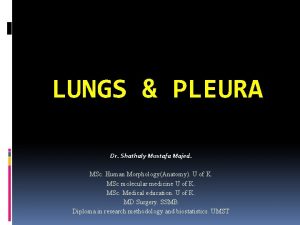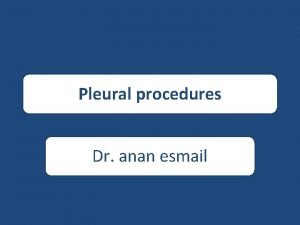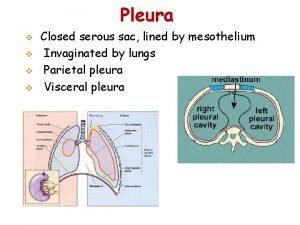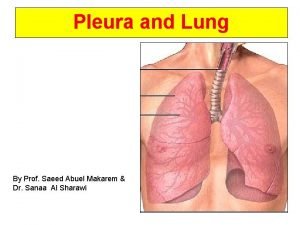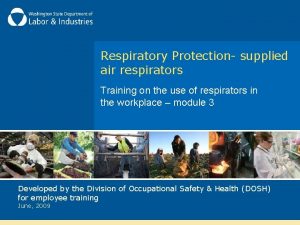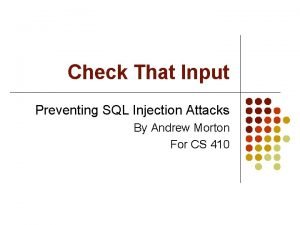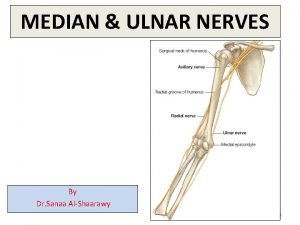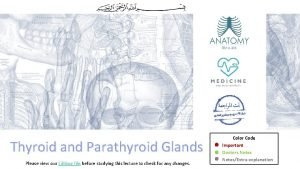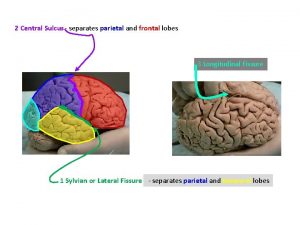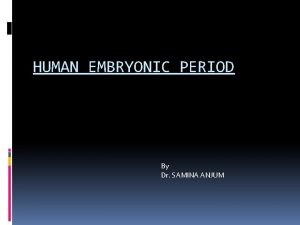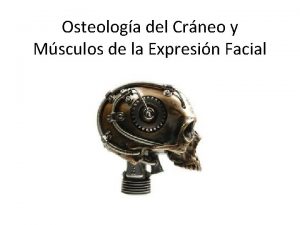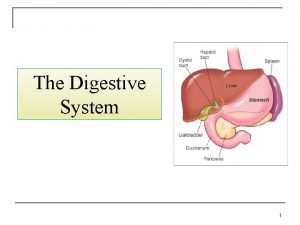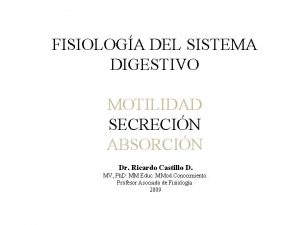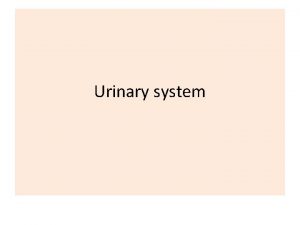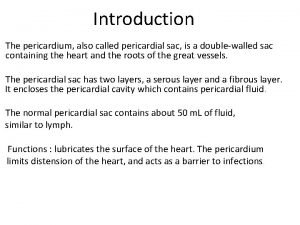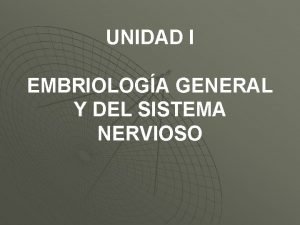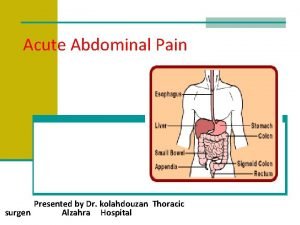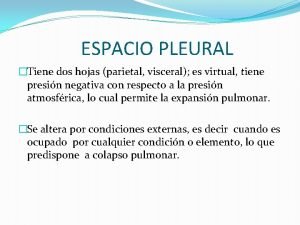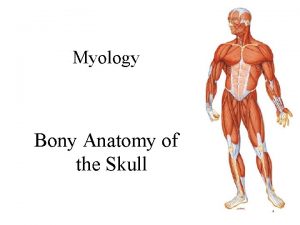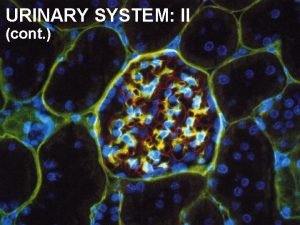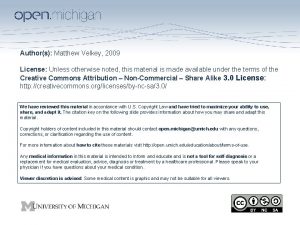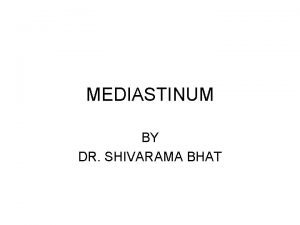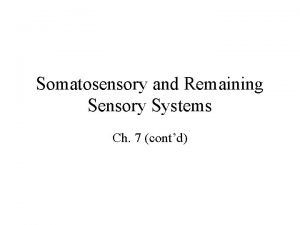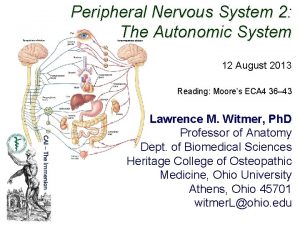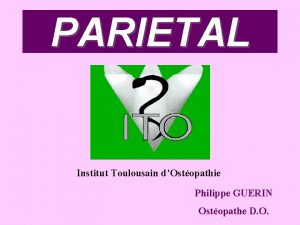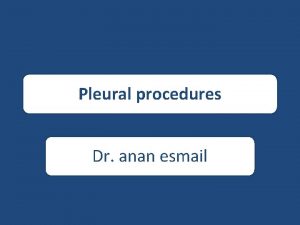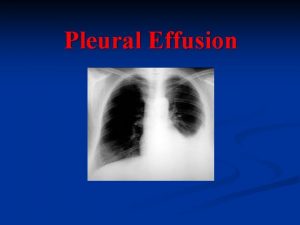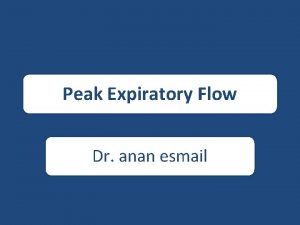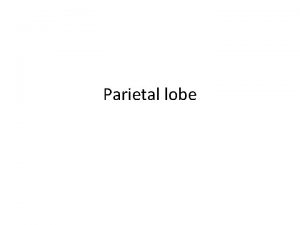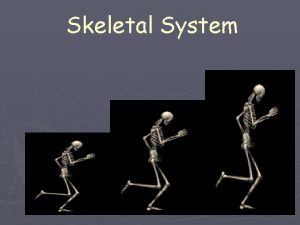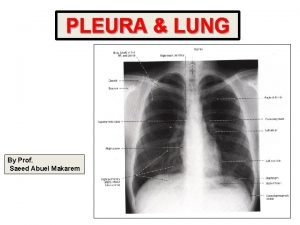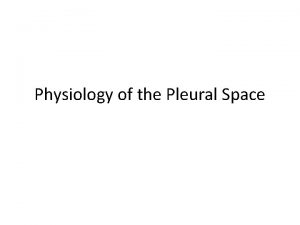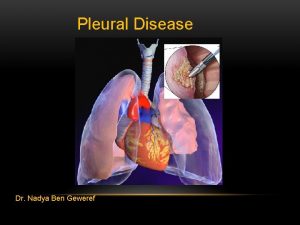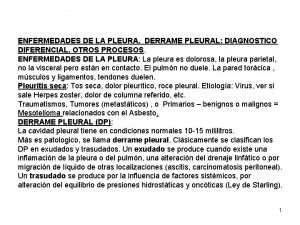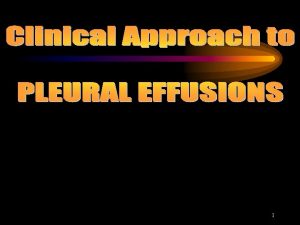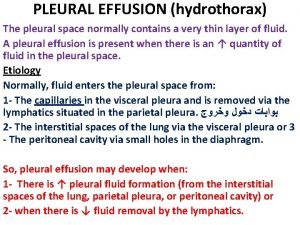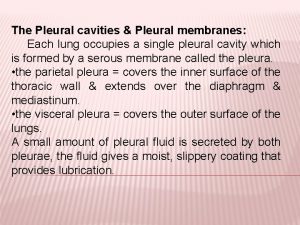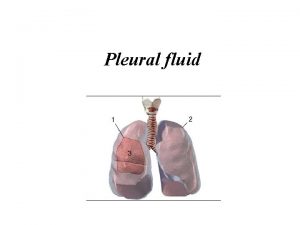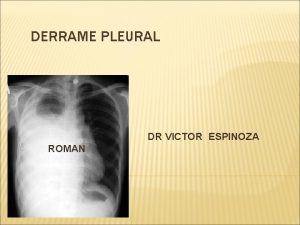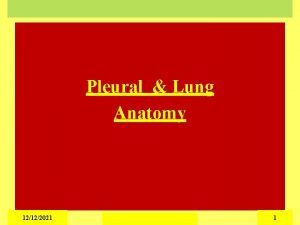Pleural procedures Dr anan esmail parietal pleura supplied
































































- Slides: 64

Pleural procedures Dr. anan esmail


parietal pleura supplied by systemic capillaries nerve ending visceral pleura supplied by bronchial capillaries no nerve ending

In the normal pleural space there is approximately 0. 1 - 0. 2 m. L/kg body weight of pleural fluid (PF)

The formation of PF is a function of parietal pleura

The PF then moves Into lymphatic ducts

Pleural disease • Pleural Effusions • Pneumothorax • Mesothelioma

Pleural Effusions mechanisms that lead to accumulation of pleural fluid? ?

Pleural Effusions Increased hydrostatic pressure in microvascular circulation (congestive heart failure)

Pleural Effusions Decreased oncotic pressure in microvascular circulation (Hypoalbuminemia )

Pleural Effusions Impaired lymphatic drainage from the pleural space (malignant effusion)

Pleural Effusions Movement of fluid from peritoneal space (ascites )

Pneumothorax air in the pleural space

Pneumothorax Classification Spontaneous Traumatic Iatrogenic

Mesothelioma malignant tumor of the pleura (asbestos)

Pleural investigation diagnostic procedures Therapeutic procedures

Indications For Thoracentesis new finding of a pleural effusion

observation Suggested diagnosis Color of fluid Pale yellow (straw) Transudate, some exudates Red (bloody) Malignancy, BAPE, PCIS, or pulmonary infarction if trauma Excluded White (milky) Chylothorax or cholesterol effusion; EVM of CVC be established atwith thelipid infusion brown Some diagnoses can bedside by visual inspection of the fluid Long-standing bloody effusion; rupture of amoebic liver abscess black Aspergillus niger infection Yellow-green Rheumatoid pleurisy Greenish tint Biliopleural fistula

Character of fluid Pus Empyema Viscous Mesothelioma Turbid Inflammatory exudates Satin-like sheen Cholesterol effusion Looks like urine Urinothorax Odor of fluid Putrid Anaerobic Empyema Ammonia Urinothorax

Pleural fluid serum CBC glucose Protein LDH

Normal Pleural Fluid less than 500 nucleated cells/L 2% neutrophils 0% basophils 7 - 11% lymphocytes 61 - 77% macrophages 9 -30% mesothelial

nucleated cell count virtually never diagnostic some settings in which the count may be helpful: above 50, 000/micro. L • complicated parapneumonic effusions above 10, 000/micro. L • pancreatitis, lupus pleuritis

Tuberculous (most common) Lymphocytes malignancy Lymphoma > 80% chronic rheumatoid pleurisy

PF eosinophilia Causes: Pneumothorax PF eosinophil count of > 10% of the total nucleated cells Hemothorax fungal disease Parasitic disease drug induced Churg strauss

Pleural fluid serum CBC glucose Protein LDH

low pleural fluid glucose concentration Rheumatoid pleurisy parapneumonic effusion or empyema Malignant effusion Lupus pleuritis Esophageal rupture

Pleural fluid serum CBC glucose Protein LDH

The Light's Criteria traditional method of differentiating Transudates And exudates

if at least one of the following three criteria is present, the fluid is defined as an exudate: Pleural fluid protein/serum protein ratio greater than 0. 5 Pleural fluid LDH/serum LDH ratio greater than 0. 6 Pleural fluid LDH greater than twothirds the upper limits of the laboratory's normal serum LDH

the fluid is defined as an exudate if: Pleural fluid protein greater than 2. 9 g/d. L (29 g/L) Pleural fluid cholesterol greater than cholesterol 45 mg/d. L Pleural fluid LDH greater than 0. 45 times the upper limit of the normal serum LDH

Processes that always cause a transudative effusion

Processes that may cause a transudative effusion, but usually cause an exudative effusion

Causes of exudative pleural effusions Infectious Bacterial pneumonia Tuberculous Malignancy Pancreatitis Pulmonary embolism Postcardiac injury syndrome Chylothorax Hypothyroidism Lupus pleuritis Rheumatoid pleurisy

exudative pleural effusions clinical history physical examination imaging studies thoracentesis with chemical Cytological are sufficient to obtain a definitive diagnosis

exudative pleural effusions When the underlying pathology remains undiagnosed (25% of cases) Histological confirmation is required

Closed pleural biopsy useful in conditions where the pleura is diffusely involved

Closed pleural biopsy considered in the setting of an undiagnosed lymphocytic effusion lymphocytes is greater than 80 percent

Closed pleural biopsy The diagnostic yield of a closed pleural biopsy is 70 to 90 percent in exudative pleural effusions due to tuberculosis

Closed pleural biopsy greater number of biopsies increase the sensitivity

Closed pleural biopsy Ultrasound guidance can improve the yield of percutaneous biopsy

Closed pleural biopsy Pneumothorax complicated 11 percent

CT guided cutting needle biopsy is typically used to diagnose malignancy

CT guided cutting needle biopsy sensitivity of 87 percent in patients with suspected malignant effusions with negative cytology

CT guided cutting needle biopsy pneumothorax occurred in only 4 percent of cases

thoracoscopy diagnostic thoracoscopy Therapeutic thoracoscopy

thoracoscopy percutaneous insertion of an endoscope into the pleural space

thoracoscopy Thoracoscopy can be performed under either local or general anesthesia

thoracoscopy It can be used to directly visualize and collect specimens from both the pleura and pleural space

thoracoscopy Thoracoscopic pleural biopsy has a diagnostic yield for malignant pleural effusions that is superior to percutaneous pleural biopsy

advanced disease associated with greater sensitivities sensitivity of cytology 45 to 90% percutaneous pleural biopsy 30 to 50% CT guided needle biopsy 87% biopsy with thoracoscopy 95 to 100%

Pleural investigation diagnostic procedures Therapeutic procedures

Chest tube Thoracostomy tube placement into the pleural cavity performed to drain abnormal collections of air or fluid

Chest tube Indications pneumothorax

Chest tube Indications hemothorax

Chest tube Indications chylous effusion

Chest tube Indications malignant effusion

Chest tube Indications parapneumonic effusion empyema

strong indicators for the need for pleural space drainage PF p. H ˂7. 20 Glucose < 60 mg/d. L or a high LDH > 1000 IU/L positive bacterial culture p. H is the most sensitive of these parameters

pleurodesis instillation of a sclerosing agent over the pleural surfaces The sclerosant agents used most commonly are talc and doxycycline

pleurodesis Doxycycline is a less effective alternative to talc

pleurodesis Talc slurry administered via chest tube appears equally effective compared with aerosolized talc administered via insufflation during thoracoscopy

pleurodesis indication Malignant pleural effusion refractory nonmalignant pleural effusions recurrent primary spontaneous pneumothorax secondary spontaneous pneumothorax

pleurodesis adverse effects Pain Fever gastrointestinal symptoms

 Difference between right and left lung
Difference between right and left lung Parietal pleura
Parietal pleura Urinothorax
Urinothorax Diaphragmatic recess
Diaphragmatic recess Costodiaphragmatic
Costodiaphragmatic Rimski bog lepote
Rimski bog lepote Key check 7
Key check 7 Ruth anan
Ruth anan Quantity supplied vs supply
Quantity supplied vs supply Power absorbed or supplied
Power absorbed or supplied Supplied air bottle watch training
Supplied air bottle watch training Change in supply and change in quantity supplied
Change in supply and change in quantity supplied Difference between supply and quantity supplied
Difference between supply and quantity supplied Air mixed gas surface supplied diving new orleans
Air mixed gas surface supplied diving new orleans Escaping all user supplied input
Escaping all user supplied input Quantity supplied vs supply
Quantity supplied vs supply Ulnar neuropathy
Ulnar neuropathy Pyramidal lobe
Pyramidal lobe Central sulcus separates
Central sulcus separates Hypochondriaca sinistra
Hypochondriaca sinistra Parietal periton nedir
Parietal periton nedir Parietal lobe function in the brain
Parietal lobe function in the brain Frontal occipital parietal
Frontal occipital parietal Parietal pain
Parietal pain What is the greater omentum
What is the greater omentum Germ layers of embryo
Germ layers of embryo Musculo orbicular del ojo
Musculo orbicular del ojo Neurómeras
Neurómeras Structures of peritoneum
Structures of peritoneum Composicion del plasma
Composicion del plasma Medial surface
Medial surface Right vs left parietal lobe
Right vs left parietal lobe Parietal layer of bowman's capsule
Parietal layer of bowman's capsule Pericardial sac
Pericardial sac Lobulo parietal funcion
Lobulo parietal funcion Embrion unilaminar
Embrion unilaminar Parietal cells
Parietal cells Placenta structure
Placenta structure Parietal pain
Parietal pain Parietal lobe and attention
Parietal lobe and attention Que tienen dos hojas
Que tienen dos hojas Facial bones anatomy
Facial bones anatomy Pylorus histology
Pylorus histology Cerebral cortex same as cerebrum
Cerebral cortex same as cerebrum Frontal lobe parietal lobe temporal lobe
Frontal lobe parietal lobe temporal lobe Kerkring
Kerkring Pathway of food from mouth to anus
Pathway of food from mouth to anus Peritoneal cavity meaning
Peritoneal cavity meaning Chiasmatic groove sphenoid bone
Chiasmatic groove sphenoid bone Epiploic foramen boundaries
Epiploic foramen boundaries Urinary system
Urinary system Grey matter and white matter in brain
Grey matter and white matter in brain The stomach
The stomach Parietal layer of bowman's capsule
Parietal layer of bowman's capsule Type of cell
Type of cell Mediastinum definition
Mediastinum definition Asterognosia
Asterognosia Dorsal view of sheep brain
Dorsal view of sheep brain Le canal des adducteurs
Le canal des adducteurs Frontanelles
Frontanelles Occipital lobe function
Occipital lobe function Sympathetic parasympathetic
Sympathetic parasympathetic Visceral serosa
Visceral serosa Ligne courbe temporale supérieure
Ligne courbe temporale supérieure Posterior parietal cortex
Posterior parietal cortex
